Click on images to enlarge
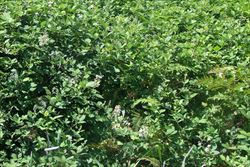
infestation (Photo: Sheldon Navie)
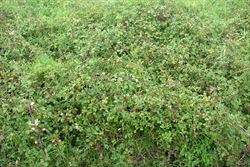
infestation (Photo: Sheldon Navie)

habit in flower (Photo: Sheldon Navie)

habit in fruit with arching stems (Photo: Sheldon Navie)
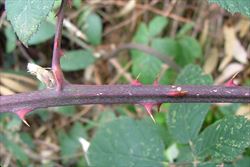
close-up showing prickles on the grooved main stem and leaf stalks (Photo: Sheldon Navie)
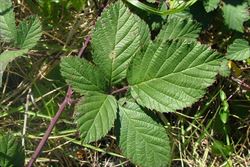
typical leaf with five spreading tooth leaflets (Photo: Sheldon Navie)
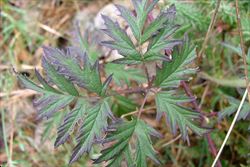
the leaves of cut-leaf blackberry (Rubus laciniatus) are easily distinguished from other blackberries by their deeply-divided margins (Photo: Sheldon Navie)
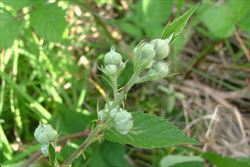
flower buds (Photo: Sheldon Navie)
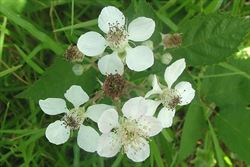
white flowers (Photo: Sheldon Navie)
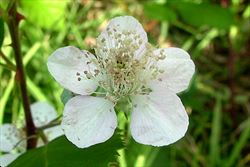
close-up of flower with numerous stamens (Photo: Sheldon Navie)
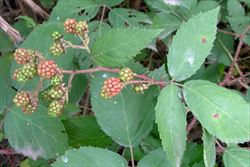
leaves, which sometimes have only one or three leaflets just below the flowers, and young fruit (Photo: Sheldon Navie)
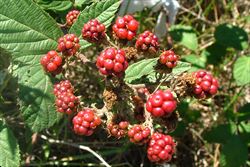
immature fruit (Photo: Sheldon Navie)
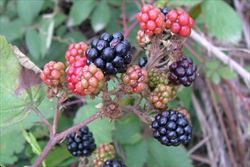
close-up of mature fruit, made up of numerous fruitlets (Photo: Sheldon Navie)
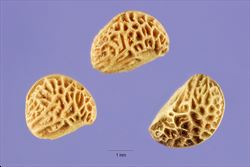
close-up of seeds (Photo: Steve Hurst at USDA PLANTS Database)
Scientific Name
Rubus fruticosus L. sp. agg.
The following species from this aggregate are currently known to be naturalised in Australia:
Rubus anglocandicans A. NewtonRubus cissburiensis W.C. Barton & Ridd.Rubus echinatus Lindl.Rubus erythrops Edees & A. NewtonRubus laciniatus Willd.Rubus leightonii Lees ex Leight.Rubus leucostachys Schleich. ex Sm.Rubus phaeocarpus W.C.R. WatsonRubus polyanthemus Lindeb.Rubus riddelsdellii RilstoneRubus rubritinctus W.C.R. WatsonRubus ulmifolius Schott var. ulmifoliusRubus ulmifolius Schott var. anoplothyrsus SudreRubus vestitus Weihe
Synonyms
For Rubus anglocandicans :
Rubus chloocladus W.C.R. Watson (misapplied)Rubus discolor Weihe & Nees (misapplied)Rubus fruticosus L.Rubus procerus P.J. Mull. ex Boulay (misapplied)Rubus ulmifolius Schott (misapplied)Rubus ulmifolius hybrids (misapplied)Rubus vulgaris Weihe & Nees (misapplied)
For Rubus erythrops:
Rubus rosaceus Weihe (misapplied)Rubus koehleri Wiehe (misapplied)
For Rubus laciniatus:
Rubus laciniatus Willd. subsp. laciniatusRubus laciniatus Willd. subsp. selmeri (Lindeb.) Beek (misapplied)Rubus selmeri Lindeb. (misapplied)
For Rubus leucostachys:
Rubus chloocladus W.C.R.Watson (misapplied)Rubus ulmifolius hybrids (misapplied)
For Rubus ulmifolius var. anoplothyrsus:
Rubus inermis Pourret (misapplied)Rubus ulmifolius Schott 'Inermis'
For Rubus vestitus:
Rubus chloocladus W.C.R. Watson (misapplied)Rubus affin. fuscus Weihe (misapplied)Rubus affin. mucronulatus Boreau (misapplied)
Family
Rosaceae
Common Names
blackberry, bramble, European blackberry, shrubby blackberry, wild blackberry
cut-leaf blackberry and cutleaf blackberry are also applied to Rubus laciniatus.
Origin
These species are all native to parts of Europe and the Mediterranean region. The native distribution of Rubus anglocandicans, Rubus cissburiensis, Rubus erythrops, Rubus leucostachys, Rubus riddelsdellii and Rubus rubritinctus is thought to be restricted to the UK. Rubus leightonii and Rubus phaeocarpus are native to southern England and northern France, while Rubus echinatus, Rubus laciniatus and Rubus polyanthemus are native to north-western Europe (i.e. the UK, Ireland and France).
Rubus ulmifolius is more widespread, being native to western and southern Europe (i.e. the UK, France, Portugal, Spain, Belgium, Germany, Luxembourg, the Netherlands, Switzerland, Italy, Albania, Bosnia and Herzegovina, Croatia, and Slovenia), the Azores, the Madeira Islands, the Canary Islands and north-western Africa (i.e. Algeria, Morocco and Tunisia).
Rubus vestitus also has a wider natural distribution, being found throughout western and central Europe (i.e. in the UK, Ireland, Denmark, Sweden, France, Portugal, Austria, Belgium, Czechoslovakia, Germany, Hungary, the Netherlands, Switzerland, Italy and Romania).
Cultivation
European blackberries (Rubus fruticosus sp. agg.) used to be deliberately cultivated in gardens, mostly for their edible fruit. Several, mostly thornless, cultivars are still grown commercially for this purpose.
Naturalised Distribution
Rubus anglocandicans is by far the most widespread and common species of this group, and is widely naturalised throughout the wetter parts of southern and eastern Australia. It is most common and widespread in eastern New South Wales, the ACT, Victoria, Tasmania, south-eastern South Australia and the coastal districts of south-western It is also occasionally naturalised in the cooler sub-coastal districts of south-eastern Queensland, in other wetter parts of South Australia, in some parts of inland southern New South Wales and on Norfolk Island.
Rubus cissburiensis is only naturalised in Victoria, but it is relatively widespread in this state.
Rubus echinatus is naturalised mainly in the northern parts of Tasmania and has occasionally also been recorded in the coastal districts of western Victoria.
Rubus erythrops is a little more widespread, being naturalised in south-western and northern Victoria, in south-eastern South Australia and in north-eastern Tasmania.
Rubus laciniatus is widely naturalised in south-eastern Australia (i.e. it is scattered in the coastal and sub-coastal districts of eastern New South Wales, widely naturalised in Victoria, locally naturalised in the Mount Lofty Ranges in south-eastern South Australia and present in western Tasmania).
Rubus leightonii is only locally naturalised in the coastal and sub-coastal districts of central New South Wales.
Rubus leucostachys is one of the more widespread species, and is found throughout large parts of south-eastern Australia (i.e. in the coastal and sub-coastal districts of southern New South Wales, in the ACT, in large parts of Victoria and Tasmania, and in many parts of south-eastern and southern South Australia).
Rubus phaeocarpus has a limited distribution in both New South Wales and South Australia. In New South Wales it is only naturalised along the Kowmung River in the Blue Mountains region, while in South Australia it is known only from the Lenswood and Paracombe areas of the Mount Lofty Ranges.
Rubus polyanthemus is widely naturalised in Victoria and is occasionally also naturalised in south-eastern New South Wales.
Rubus riddelsdellii is locally naturalised in the Mount Lofty Ranges in south-eastern South Australia.
Rubus rubritinctus is also mainly found in the Mount Lofty Ranges region in south-eastern South Australia, but it is occasionally also naturalised in Tasmania.
Rubus ulmifolius var. anoplothyrsus has only been recorded from south-eastern South Australia and south-western Western Australia, but it may be more widespread.
Rubus ulmifolius var. ulmifolius has been recorded from large parts of mainland southern Australia (i.e. in parts of eastern New South Wales, large parts of Victoria, south-eastern South Australia and the coastal districts of south-western Western Australia).
Rubus vestitus has a relatively widespread but scattered naturalised distribution in south-eastern Australia. It has occasionally been recorded in the central and southern tablelands regions in New South Wales, in southern Victoria, in Tasmania and in south-eastern South Australia.
Habitat
Weeds of disturbed sites, waste areas, roadsides, gardens, waterways (i.e. riparian vegetaiton), swamps, pastures, grasslands, orchards, plantations, bushland, open woodlands, forest margins and closed forests in temperate and sometimes also sub-tropical regions.
Habit
Upright (i.e. erect), arching or scrambling shrubby plants that tend to grow in dense thickets. They usually grow 1-2 m tall but some species can occasionally reach up to 7 m in height.
Distinguishing Features
- upright, arching or scrambling shrubby plants usually forming dense thickets.
- their stems are almost always armed with prickles and become woody with age.
- their compound leaves have three or five spreading leaflets and are usually borne on prickly stalks.
- these leaflets are usually egg-shaped in outline or oval in shape with variously toothed margins.
- its white or pale pink flowers have five petals, five sepals, and numerous stamens.
- its fleshy fruit (10-30 mm across) turn from green to red as they begin to mature and then glossy black when fully ripe.
- these berry-like fruit are actually made up of many smaller fruit, each containing a single small seed.
Stems and Leaves
The upright (i.e. erect), arching or trailing main stems (i.e. primocanes) are almost always armed with stout prickles (3-12 mm long) that are either curved or straight. These stems can be finely hairy (i.e. pubescent), particularly when they are young, or hairless (i.e. glabrous). They are green or reddish in colour when young, becoming woody with age, and can be round, ribbed or angular in cross-section. The shorter flowering branches (i.e. floricanes) are somewhat similar, but tend to be rounded and more hairy (i.e. pubescent) than the main stems (i.e. primocanes).
The palmately compound (i.e. digitate) leaves are alternately arranged, with three or five leaflets, and are borne on prickly leaf stalks (i.e. petioles). These leaves are often whitish-hairy (i.e. pubescent) below with darker green, less hairy or hairless (i.e. glabrous), upper surfaces. Leaflets are egg-shaped in outline (i.e. ovate) or oval (i.e. elliptic) in shape (30-90 mm long and 25-50 mm wide) with variously toothed (i.e. serrated) margins. Small prickles may also be found on the underside of these leaflets, particularly along their midribs.
Flowers and Fruit
The flowers are borne in clusters at the tips of short side branches. They are white or pale pink in colour (20-30 mm across) with five petals (about 10 mm long), five sepals, and numerous stamens. Flowering occurs mainly during late spring and summer.
The fruit are commonly referred to as 'berries', but are actually aggregates consisting of many fleshy segments (i.e. druplets), each of which contains a single small seed. These rounded (i.e. globular) fruit turn from green to red in colour as they begin to mature, and are eventually glossy black in colour when fully ripe (10-30 mm across).
The seeds are light or dark brown in colour, irregularly shaped or almost triangular (2-3 mm long), and have deeply pitted surfaces.
Reproduction and Dispersal
This plant reproduces by seed, however it may also produce suckers from its woody rootstock and plantlets from the stem tips that come into contact with the soil surface (this process is known as layering).
Seeds are spread by animals (particularly birds) that eat the fruit, and both seeds and stem fragments are dispersed in dumped garden waste.
Environmental Impact
European blackberries (Rubus fruticosus sp. agg.), as a group, are classified as a Weed of National Significance (WoNS). They are regarded as very significant environmental weeds in Victoria, Tasmania, South Australia and Western Australia, and are also environmental weeds in New South Wales, the ACT and Queensland. These species are actively managed by community groups in Victoria, Tasmania, South Australia, New South Wales, Western Australia and the ACT.
Legislation
This species is declared under legislation in the following states and territories:
- ACT: C3 - a pest plant that must be contained.
- New South Wales: Class 4 - a locally controlled weed. The growth and spread of this species must be controlled according to the measures specified in a management plan published by the local control authority and the plant may not be sold, propagated or knowingly distributed (throughout the entire state). This declaration does not include the cultivars 'Black Satin', 'Chehalem', 'Chester Thornless', 'Dirksen Thornless', 'Loch Ness', 'Murrindindi', 'Silvan', 'Smoothstem' and 'Thornfree'.
- Northern Territory: A - to be eradicated (throughout all of the Territory), and C - not to be introduced into the Territory.
- Queensland: Class 3 - this species is primarily an environmental weed and a pest control notice may be issued for land that is, or is adjacent to, an environmentally significant area (throughout the entire state). It is also illegal to sell a declared plant or its seed in this state.
- South Australia: 3* - declared in Class 3c, this species is required to be controlled in part of the state only. This declaration excludes detached fruit and certain cultivars (i.e. 'Black Satin', 'Dirksen Thornless', 'Smoothstem', 'Thornfree', 'Loch Ness' and 'Chester Thornless'), provided that they are planted and maintained for domestic or commercial purposes under conditions approved by the Animal and Plant Control Commission.
- Tasmania: D - the importation or sale of this species is prohibited and measures to reduce its population in an area, eradicate it from an area, or restrict it to a particular area may be required. This declaration does not include commercial varieties of blackberry (i.e. thornless varieties) or fruit intended for human consumption.
- Victoria: C10 - all reasonable steps must be taken to control the weed and prevent its spread (in the Wimmera, Glenelg, North Central, Corangamite, Port Phillip West, Port Phillip East, Goulburn, North East, West Gippsland and East Gippsland regions).
- Western Australia: P1 - trade, sale or movement into the state prevented, P2 - to be eradicated (in the Boddington local authority area only), and P4 - infestations to be contained (in the City of Albany, Augusta-Margaret River, Boyup Brook, Bridgetown-Greenbushes, City of Bunbury, Busselton, Capel, Collie, Cranbrook, Dardanup, Denmark, Donnybrook-Balingup, Harvey, Manjimup, Mandurah, Murray, Nannup, Plantagenet, Serpentine-Jarrahdale and Waroona local authority areas).
Management
For information on the management of this species see the following resources:
- the National Weeds Strategy Strategic Plan for blackberry (Rubus fruticosus L. agg.), which is available online at http://www.weeds.org.au/docs/bbstrat.pdf.
- the Victorian Department of Sustainability and Environment Landcare Note on this species, which is available online at http://www.dse.vic.gov.au.
- the Tasmanian Department of Primary Industries and Water weed service sheet on this species, which is available online at http://www.dpiw.tas.gov.au.
- the Biosecurity Queensland Fact Sheet on this species, which is available online at http://www.dpi.qld.gov.au.
- the Western Australian Department of Agriculture and Food Farmnote on this species, which is available online at http://www.agric.wa.gov.au.
Similar Species
There are numerous other Rubus species that are native to, or naturalised, in Australia. Some of these other species can be difficult to distinguish from European blackberries (Rubus fruticosus sp. agg.), and a specialist key should be consulted.
The most recent, comprehensive, and easy to use resource is the Blackberry: an identification tool to introduced and native Rubus in Australia CD-ROM.

